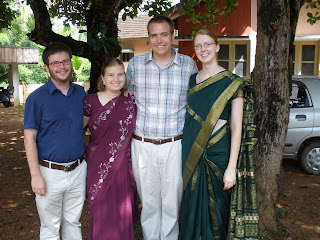 I have been living in Kerala long enough that I now sometimes forget where I am. Let me explain: My life has normalized into daily and weekly routines. I eat the same foods and sleep in the same bed and see the same coconut trees every day. So sometimes I forget that I’m living my life on the opposite side of the world from where I grew up. And then I remember. Sometimes I will simply look at the trees with fresh eyes, or maybe I’ll eat some new, previously unknown, and delicious fruit. And in re-sensing the world that surrounds me here, I remember: “Oh yeah! I’m in India!”
I have been living in Kerala long enough that I now sometimes forget where I am. Let me explain: My life has normalized into daily and weekly routines. I eat the same foods and sleep in the same bed and see the same coconut trees every day. So sometimes I forget that I’m living my life on the opposite side of the world from where I grew up. And then I remember. Sometimes I will simply look at the trees with fresh eyes, or maybe I’ll eat some new, previously unknown, and delicious fruit. And in re-sensing the world that surrounds me here, I remember: “Oh yeah! I’m in India!”So in this post, I felt the need to re-document my geography. To remind myself (and maybe you too) of where I am in the world. So here is a map of India with Kerala highlighted. The capital of the state is Thiruvananthapuram (or Trivandrum for short), but I live in Pathanamthitta District (see second map), and the other three YAV volunteers live in Kottayam District.

The language here, as I’ve already mentioned, is Malayalam. I am surrounded by this language and am still struggling to learn it. The letters are especially beautiful when written, curving and arching in some confusing, graceful dance. Click here to see what Malayalam script looks like.
So yes: I am in India! Although I forget my geography sometimes, little things help me remember:
- When the lights go out, I love it. The electricity fails here pretty often, but in the evenings when the power goes out, I can’t stop smiling. In the dark, the students and teachers laugh more, are more free with each other. There must be something about being in the dark that makes people more open. In the dark we can’t stop laughing and smiling because, when we can’t see each other’s faces everything is somehow funny, wonderful, and shared.
- When I walk outside of my room I’m immediately surrounded by some 15 or 20 11- and 12-year-old girls who live in the dormitory where my room is. They all run up to me, happy to talk with me in their broken English, which they’re still learning. This happens at least three times every day.
- I have eaten several fruits here in whose existence I still do not believe. The most recent example is a custard apple. The texture is a little like custard, but it has nothing to do with an apple. Opening the grenade shaped (and textured) fruit, exposes a bunch of fleshy white pieces, each with a large seed inside the white fleshy fruit. This white flesh has a sort of custardy consistency. It’s sweet and good, but it tastes like nothing I’ve ever experienced before, so I can’t even draw an appropriate comparison. I’m sure this fruit cannot exist. But I’ve eaten it. Twice.
- Last week I almost died crossing the street. Traffic here is insane, and being a pedestrian sometimes feel suicidal. In most places in Tiruvalla there is just one wide-laned road with traffic speeding along in both directions and cars illegally passing, weaving in and out of fast, oncoming traffic. It’s pretty frightening. What is maybe more frightening, is that I’m now almost completely desensitized to this way of driving. But I forgot for a moment that I was in India, and last week I tried to cross the street without checking for cars illegally passing in the wrong lane. One such vehicle narrowly braked in time and I touched the hood of the car as I dodged around it. [Readers, please do not think that I am in too much danger of dying on the roads. Think of all our U.S. traffic accidents. I’m truly just as safe here as I would be driving in the U.S.]
- When there’s no water – that is, when the pipes are empty and the faucets don’t work – I go to the school’s giant well and pull up a bucket full of clean, drinking water that I can pour directly into my water bottle.
- When I had lunch with an older friend of mine here, she offered me a fork for the first time since September. (Everyone in India eats with their right hand, a surprisingly efficient way of eating once you get used to it. There are also fewer dishes to wash.) Anyway, I had to refuse the fork because I don’t know how to eat Kerala cuisine with anything but my hands.
- It is “winter” in Kerala and many people dress for the “cold” by donning sweaters and wrapping shawls and blankets around their shoulders in the morning. I think it’s finally comfortable at a balmy 75 degrees F.
- One night I stopped at the door of my room and stared out at the night. The full moon was a brilliant yellow/orange color and shone through the branches of the coconut tree near my bedroom window. The tree was silhouetted against the fullness of the bright moon, and the beauty of the scene was stunning.
Oh.
Wow.
I’m in India!





